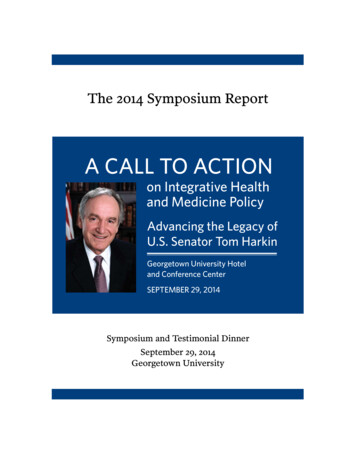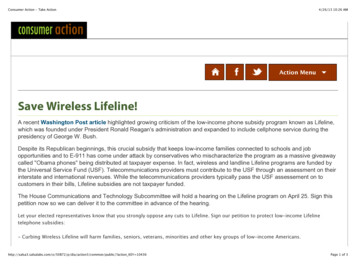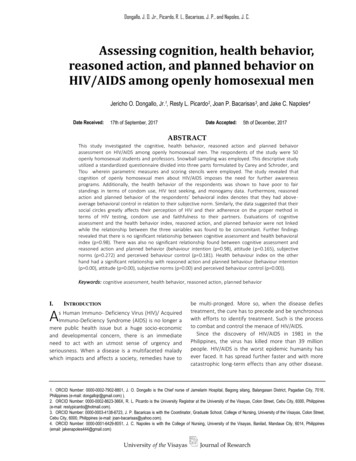
Transcription
The 2014 Symposium ReportA CALL TO ACTIONon Integrative Healthand Medicine PolicyAdvancing the Legacy ofU.S. Senator Tom HarkinGeorgetown University Hoteland Conference Centerseptember 29, 2014Symposium and Testimonial DinnerSeptember 29, 2014Georgetown University
AcknowledgmentsHost: Adi Haramati, PhD, Georgetown University Medical CenterDiamond Sponsors:Academic Consortium for Complementary and Alternative Health CareAcademy of Integrative Health & MedicineAcademic Consortium for Integrative Medicine & HealthThe Institute for Integrative HealthLIFE UniversitySamueli InstituteIntegrative Health Policy ConsortiumSponsoring Organizations:Gold: Hyland’s FoundationSilver: Bastyr University National Center for HomeopathyBronze:Accreditation Commission for Acupuncture and Oriental Medicine American College of Traditional Chinese Medicine Association of Accredited Naturopathic Medical Colleges Council of Colleges of Acupuncture and Oriental Medicine Logan University Maryland University of Integrative Health National Certification Commission for Acupuncture and OrientalMedicine National College of Natural Medicine New York Chiropractic College Northwestern Health Sciences University Oregon College of Oriental Medicine Palmer College Southern California University of Health Sciences SouthwestCollege of Naturopathic MedicinePlanning CommitteeBrian Berman, MDMargaret Chesney, PhDRenee Motheral ClugstonGerry Clum, DCIan Coulter, PhDDavid Eisenberg, MDChristine Goertz, DC, PhDAdi Haramati, PhDNick Jacobs, FACHEWayne Jonas, MDBenjamin Kligler, MDMary Jo Kreitzer, RNLexie RobinsonNancy Sudak, MDTaylor WalshJoan Walter, JD, PAJohn WeeksLen Wisneski, MDAlyssa Wostrel, MBA, DiHomSymposium Project SupportProject Coordinator: Renee Motheral ClugstonProgram Content and Production:Editor: Taylor WalshReview: John Weeks, Alyssa WostrelDesign: Communications Office, Georgetown University Medical CenterEvent Rapporteurs: Jade Wood, Denise GrahamAudio, Video recordings: Karen AllenSymposium Report:Editor: Taylor WalshReview: John Weeks, Alyssa WostrelDesign: Claire MacMaster, Barefoot Art Graphic DesignReport production on behalf of the planning committee, sponsors and participantscoordinated by the Integrative Health Policy Consortium
A Call to ActionOn Integrative Health and Medicine PolicyAdvancing the LegacyOf U.S. Senator Tom HarkinSymposium ReportAugust 2015Symposium and Evening Tribute to U.S. Senator HarkinSeptember 29, 2014Georgetown UniversityHotel and Conference Center
A Call to Action on Integrative Health and Medicine PolicyAdvancing the Legacy of U.S. Senator Tom HarkinThe 2014 SymposiumCONTENTS2Acknowledgments6Executive Summary8Welcome and Introduction to the DayAdi Haramati, John Weeks, Len WisneskiMORNING PRESENTATIONS9Integrative Health in the ACA: Where Have We Come From?Where Do We Go Next?Moderator: Len Wisneski MD (Chair, Integrative Health Policy Consortium)Themes and Presenters:912141619Non-Discrimination in Health CareMichael Traub, ND (Non-Discrimination Committee Co-Chair,Integrative Health Policy Consortium)National Prevention, Health Promotion and Public Health CouncilJanet Kahn, PhD, LMT (Member, Prevention Advisory Group of theU.S. National Prevention Council)Patient-Centered Outcomes Research InstituteChristine Goertz DC, PhD (Member, Board of Governors, and Chair,Science Oversight Committee, PCORI)Integration in Practice: Accountable Care and Patient Centered Medical HomesCourtney Baechler, MD (Vice-President, Penny George Institute of the Allina Health System)Healthcare Workforce: Interprofessional Practice and EducationJohn Weeks (Executive Director, Academic Consortium for Complementaryand Alternative Health Care)KEYNOTE24The Imperative for Integrative Health and Medicine in the United StatesEric Schoomaker, MD, PhD (Lt. Gen, US Army, Ret.; former Surgeon General of the Army)Introduction: Wayne Jonas, MD (CEO, Samueli Institute)4Symposium Report: Advancing the Legacy of US Senator Tom Harkin in Integrative Health & Medicine
AFTERNOON PRESENTATIONS26Emerging Trends and Opportunities in Integrative Health & MedicineModerator: Margaret Chesney, PhD (Chair, Academic Consortiumfor Integrative Medicine & Health)Themes and Presenters:262730333536Building the Capacity for Real World Effectiveness Research for Integrative HealthJosephine Briggs, MD (Director, NIH National Center for Complementaryand Alternative Medicine)Intersecting Futures for Public Health, Primary Care andIntegrative Health and MedicineClem Bezold, PhD (Founder and Chair, Institute for Alternative Futures)“Mission Thrive” and Nature as HealthChristopher D’Adamo, PhD (Director of Research, University of Maryland Centerfor Integrative Medicine)Creating Wellbeing Leadership GroupWayne Jonas, MD (CEO, Samueli Institute)Wholistic Approaches to Community Health and WellbeingAhmed Calvo, MD, MPH (CMO and Senior Adviser, Office of IT and Quality,Health Resources Services Administration)Reflections on the DayMary Jo Kreitzer, RN, PhD, FAAN (Member, Planning Team)37Organization Commitments41Dinner Testimonials: Gratitude to Senator Tom Harkin43Remarks by Sen. Barbara Mikulski44Remarks by Sen. Tom Harkin46Tribute Letter to Sen. Harkin from IHPC48Participants5Symposium Report: Advancing the Legacy of US Senator Tom Harkin in Integrative Health & Medicine
Executive SummaryOn September 29, 2014 120 leaders in integrative health and medicine (IHM) convened at Georgetown Universityto celebrate the contributions that U.S. Senator Tom Harkin of Iowa has made to the acceptance and growth ofintegrative health during his congressional career. From the symposium program:“We cannot overstate the influence Sen. Harkin has had on our lives and our commitment to do everythingpossible to transform the present medical industry toward a system that focuses on health and wellbeing.”The list of Senator Harkin’s groundbreaking contributions: Founding of the NIH Office of Alternative Medicine, and its later expansion to become the National Centerfor Complementary and Alternative Medicine, NCCAM (now the National Center for Complementary andIntegrative Health, NCCIH). His long-standing support for the integration of chiropractic. The White House Commission on Complementary and Alternative Medicine Policy in 1998. Provisions in the Affordable Care Act that mandate “Non-Discrimination in Healthcare” and others thatassert the importance of complementary and integrative health practices and practitioners. His outspoken advocacy for the integrative medicine model. His driving passion for prevention and health promotion. The creation of the visionary, whole-system “National Prevention, Health Promotion, and Public HealthCouncil.”(Sen. Harkin’s remarks during the dinner testimonial are on page 44 )In addition to celebrating this powerful legacy, the symposium presentations were organized around a “Callto Action” for the future, for which speakers covered the most important outcomes and trends since the ACAbecame law in 2010:1.By reviewing the initiatives undertaken by the IHM community since its members held the “2010 Stakeholder’sConference,” also at Georgetown, shortly after the ACA was signed into law;2.By forecasting the opportunities to participate in and shape the dramatically changing health care andwellness environments, where quality and reducing costs of care — the keys to IHM value — are being builtinto new payment models.While the results of the November 2014 national election brought new leadership to Congressional committeesimportant to the field, and many aspects of the ACA remain unfulfilled (notably the implementation of Section2706, “Non-discrimination”), as you will read here, symposium speakers laid out the paths critical for IHMinvolvement and leadership in the important years ahead, in areas such as: Interprofessional education Advancing non-pharmaceutical treatment options for pain Ensuring that integrative treatments become part of patient-centered outcomes research Guiding major healthcare institutions that are now considering integrative health approaches to care Collaborations with the public health sector Continuing to advance comparative research on IHM cost benefits Ensuring IHM its place in lifestyle, prevention and health promotion initiatives6Symposium Report: Advancing the Legacy of US Senator Tom Harkin in Integrative Health & Medicine
As noted by Samueli Institute CEO Wayne Jonas: “The things that we used to talk about in the closet or just withtwo or three other people are now on the stage of all major groups in the country.”Whether those stages are in new integrative primary care clinics or in the healing ambitions of a nation state (i.e.:Samueli client, the Netherlands), the presentations clearly show a collective enterprise come of age, but one thatis also in the midst of managing its own transformations.To that end, the symposium’s” Call to Action” included a declared commitment — organizational and personal —by the participants, which you can find on page 37.7Symposium Report: Advancing the Legacy of US Senator Tom Harkin in Integrative Health & Medicine
Welcome and Introduction to the DayConference host Adi Haramati, PhD welcomed the symposium participants, noting the historic role Georgetownhas played as a setting for a number of formative gatherings of the IHM community. These have included: The 2001 “National Policy Dialogue to Advance Integrated Health Care: Finding Common Ground” The 2005 “National Education Dialogue to Advance Integrated Health Care: Creating Common Ground,”and Twice hosting the “International Congress for Educators in Complementary and Integrative Medicine,”co-sponsored by Georgetown, the Academic Consortium for Complementary and Alternative Healthcare(ACCAHC) and the Academic Consortium for Integrative Health and Medicine (ACIMH: The Consortium). The 2010 “The Affordable Care Act & Beyond: A Stakeholder Conference on Integrated HealthcareReform.”Dr. Haramati also noted that the Integrative Health Policy Consortium (IHPC), a main sponsor of the Symposium,was birthed at one of those early Georgetown meetings.John Weeks, executive director at ACCAHC and coordinator of the symposium planning committee and LenWisneski, MD, chair of the IHPC, and member of the planning committee, each noted Senator Harkin’s role as thefirst public official to call for moving the nation from a system of sick care to a wellness society.“It is meek and fitting that we’re meeting here at Georgetown,” Mr. Weeks said. He recalled that in 2010,just months after the passage of the Affordable Care Act, Georgetown hosted the most important convenedsymposium of the time, the Stakeholder Conference, which led directly to this “Call to Action” symposium. Mr.Weeks recalled meetings as far back as 1996 in which Harkin advised a group of early CAM/integrative healthleaders of the importance of working together. He said that Sen. Harkin advised that, “we figure out what wewanted as a group. He gave us the potential of the dream. He wanted us to come together as a group that wouldhelp him on the Hill. We have since met multiple times to explore and create common ground.”He noted Sen. Harkin’s sustained activism on behalf of complementary and integrative health, from the 1990’sthrough the passage of the Affordable Care Act (ACA) and its focus on ending discrimination against providers, aprocess in which Harkin was still actively engaged at the time of the symposium.Said Dr. Wisneski: “It is an honor to be with fellow pioneers. After 40 years we are at the tipping point. Virtuallyevery stakeholder group in the US is speaking about health, wellness, and wellbeing. Now is time to roll up oursleeves and do the work. We are no longer fighting an uphill battle. We are being sought after as experts toimplement what we have been working on for half a century.”Mr. Weeks asked: “What is the message as we try to move forward to new health creation?” He noted the greatchallenge that comes with healthcare transformation and quoted Czech Nobel Laureate Vaclav Havel: “Hope isnot the same thing as optimism. Hope is not doing a thing out of the belief that good will come, but because it isthe right thing to do.”“In 2010 we were celebrating areas of ACA,” added Dr. Wisneski. “We’ve accomplished some of what we hadhoped for. We have great plans for the future.”8Symposium Report: Advancing the Legacy of US Senator Tom Harkin in Integrative Health & Medicine
MORNING PRESENTATIONSIntegrative Health in the ACA: Where Have We Come From?Where Do We Go Next?Moderator: Len Wisneski, MD (Chair, Integrative Health Policy Consortium)Non-Discrimination in Health CareMichael Traub, NDCo-chair, Non-Discrimination Committee, Integrative Health Policy Consortium(NOTE: Federal and especially state developments related to non-discrimination have been substantial since the Symposium.A summary is shown at the end of this section.)Michael Traub, ND, DHANP, FABNO reviewed the actions undertaken after the 2010 Stakeholder Conferenceon seven recommendations to Federal healthcare policy and program managers for support of the inclusion ofcomplementary and integrative health practices and providers in provisions of the Affordable Care Act, notablySection 2706, “Non-discrimination in Healthcare.” These recommendations fell into two primary areas:1.Extending the values of non-discrimination into other areas that affect integrative disciplines, includingfinance and loan repayment, and inclusion of IHM in public health programs.2.Ensuring that the Department of Health and Human Services and other federal agencies properly directstate-based compliance with Section 2706.Due to the demands of confronting the ineffectual federal guidance on Section 2706 that HHS issued in 2013,most actions in the first category were set aside1. Dr. Traub reviewed the actions most pertinent to supportingcompliance with Section 2706:1.The non-discrimination language should specify examples of insurer actions that are prohibited and thosepermitted under Section 2706.2.CMS or the Secretary of HHS should issue guidance to insurers (including Medicare Advantage, ERISA,and state plans) and providers affirming that licensed CAM provider types must be included in an insurer’snetwork, and thus be accessible to a member as readily as are other providers.4.IHPC and its Partners for Health established a task force to: Formally submit recommendations on rulemaking language to HHS Determine other actions Work with state-level insurance commissioners and insurance exchanges and with the NationalAssociation of State Insurance Commissioners (NAIC), and other major decision-makers.5.Request that congressional leaders adopt these recommendations as part of their agenda.1 Recommendations tabled for later consideration:3. Add regulatory language to ensure that non-discrimination is also applied to (1) grants to educational institutions; (2) loan repayment programs; and (3) residency funding.5. Consider a comprehensive non-discrimination bill for the Public Health Service Act to correct issues of loan repayment, eligibility for the National Health ServiceCorps, Public Health Service, and a variety of federal programs.7. Confer with key legislators to determine whether Medicare and Medicaid are best dealt with as part of this law during rulemaking, or inclusion separately in theSocial Security Act.9Symposium Report: Advancing the Legacy of US Senator Tom Harkin in Integrative Health & Medicine
Dr. Traub described IHPC-organized activities that focused on the overlapping challenges that arose from agencyinaction related to recommendations 1, 2 and 4 above. (Objective #5 has been strongly sustained by senatorsHarkin, Mikulski, Sanders and others.) Major activities undertaken since 2010: Congressional briefings were held on Capitol Hill for key Senate and House staff members IHPC and its Partner for Health member the American Association of Naturopathic Physicians (AANP)retained former State of Washington insurance commissioner Deborah Senn, Esq. to advise on 2706implementation and compliance Worked with the American Association of Acupuncture and Oriental Medicine (AAAOM) and others toinclude AOM and other integrative disciplines in states’ Essential Health Benefits (EHBs) defined by theAffordable Care Act. IHPC members met with state insurance commissioners, insurance company executives and other stateregulators and with several HHS Regional Directors who were supportive of non-discrimination objectives The IHPC board approved the development of a consumer-facing website and social media-basedinformation and engagement resource to spur grass roots support for 2706 compliance, CoverMyCare.org(http://www.covermycare.org) The IHPC board approved creation and publication of “Integrative Health and Medicine: Today’s Answerto Affordable Healthcare: Health Creation Economics,” a first-time compilation of research showing thecomparative economic benefits of multiple IHM disciplines in practice.The Department of Health and Human Services (HHS) FAQ on Section 2706 (April 2013)When the shortcomings of the guidance on Section 2706 issued by HHS to insurers became evident in the springof 2013, IHPC concentrated its resources on responding to the seriously misguided nature of this FAQ. IHPC and its members sought Senator Harkin’s intervention In July 2013 the Senate Appropriations Committee rebuked the FAQ for ignoring the intent of thelegislation and directed the agencies to re-write it Not until the spring of 2014 did HHS open a public comment period for response to its “Request forInformation on Non-discrimination” (the RFI) * IHPC representatives met with HHS’s national liaison to providers and with the national liaison to the Centerfor Consumer Information & Insurance. IHPC Non-discrimination Committee member John D. Blum, JD, wrote an article for the April BloombergBNA’s Health Law Reporter that outlined serious shortcomings in the FAQ2. IHPC conducting a large (5,000 ) nationwide practitioner survey in 2014 on 2706 compliance that revealed:»» The vast majority of insurers were doing nothing to comply with 2706»» Some carriers covered services out-of-network and ignored practitioner requests to be included innetwork»» Only a small number of insurers were acting in accordance with the statutory intent of 2706* IHPC’s primary recommendation to the Spring 2014 RFI was that the agencies revoke the guidance issued inApril 2013 and issue new guidance based on the specific provisions and intent of the legislation.Despite IHPC’s advocacy and that of other provider and patient organizations through 2014, the U.S. departmentsof Health and Human Services, Treasury, and Labor remained unresponsive to the 2013 order from the SenateAppropriations Committee. On June 24, 2014 the Committee again advised HHS: “CMS has not complied withthis directive (to correct the 2013 FAQ on Section 2706). The Committee expects the corrected FAQ by November3, 2014, or an explanation for ignoring congressional intent.”2BNA’s Health Law Reporter, 23 HLR 574, 4/24/14. http://www.bna.com10Symposium Report: Advancing the Legacy of US Senator Tom Harkin in Integrative Health & Medicine
Symposium Summary:Dr. Traub reported: “The problematic guidance (the ‘FAQ’) issued on 4/29/13 by HHS, Dept. of Labor and theDept. of Treasury narrowed the meaning of 2706 in ways that were not intended by the statute, adding criteriathat were wholly arbitrary and counter-productive, providing multiple loopholes for insurers to avoid compliance.Three federal agencies have allowed insurers to violate a federal law, and to allow the very discriminatorypractices that Section 2706 was intended to prevent. Despite IHPC progress toward implementation of 2706,the current situation is unsatisfactory.” He recommended strengthening the community’s policy capability byaligning IHPC with the Academy of Integrative Healt
Georgetown University A CALL TO ACTION on Integrative Health and Medicine Policy . MBA, DiHom. A Call to Action On Integrative Health and Medicine Policy . August 2015 Symposium and Evening Tribute to U.S. Senator Harkin September 29, 2014 Georgetown University Hotel and Conference C











